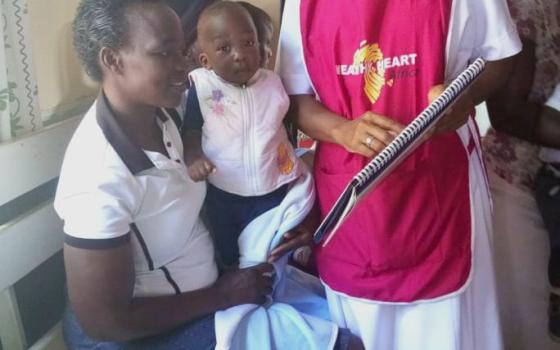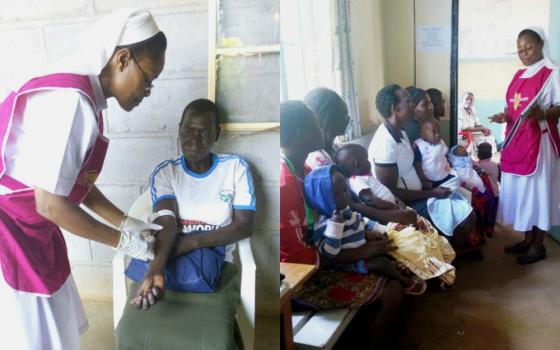Given the high number of people living with HIV/AIDS in Siaya in southwestern Kenya and the stigma associated with the disease, especially among children of school age, Sr. Mary Nafula of the Franciscan Sisters of St. Anna and her team have created a welcoming environment for such youth. In August 2005, they established a youth-friendly clinic where young nurses, some of whom are HIV-positive, attend to them.
The sisters also have a comprehensive care clinic for HIV-positive mothers and pregnant women that works to minimize mother-to-child transmission of HIV. When a child is born to an HIV-positive mother, they monitor them for two years to ensure they are HIV-negative. If a child turns out to be HIV-positive, the sisters journey with them throughout their lives.
According to an August 2018 report by the Kenya AIDS Strategic Framework, about 200,000 adults in Siaya County, about 24% of the adult population, have HIV and AIDS, the second-highest percentage in the lake region.
GSR: What is the background of St. Elizabeth Hospital, and how does the facility operate?
Nafula: St. Elizabeth Hospital is a faith-based health institution that uses our services. The facility was established in the 1960s to provide health care services to pregnant mothers, ensure safe deliveries and scale up immunization to children under 5 as a way of addressing high maternal and infant mortality rates. With the rising needs for general health care, the outpatient department was opened, following with the establishment of inpatient services that has capacity of 50 beds.
What does your work entail?
I'm a psychological nurse by profession, and I also act as a clerk to patients when there is a staffing shortage. I handle the tough maternity cases and counsel married couples, since I have done marriage encounter. I support adolescents who are HIV-positive by empowering them to speak about their status and encouraging them to work hard in school for a better future.
I work with community health workers in households where we check and refer the sick family members, but we strictly deal with children under 5 years old and pregnant mothers, who we encourage to attend immunization and antenatal clinics. Pregnant mothers are encouraged to at least pay four visits and do two ultrasounds to check the position of the baby.
I also work with support groups for those who are on antiretroviral drugs in collaboration with the county government to give feedback on patients' progress; challenges facing patients, like if they have side effects with their drugs; and discussions that take place in support groups. I then present monthly reports for the purpose of ordering vaccines, safety sharps, tuberculosis drugs, Vitamin C and A for the children, food supplements, anti-worm drugs and clinical registers for the month.
What informed you to begin a peer-counseling project for young people living with HIV/AIDS?
I started the peer-counseling project when I realized I was hitting a wall despite administering antiretroviral drugs and addressing the issues of adherence to treatment and good morals. The number of new infections kept increasing, mortality rate was also going up, and reinfection was rising.
Patients never wanted to talk about their HIV status, so I had to come up with a strategy to allow me get positive results from the young people. I got a job for two of them, and their work was to bring their peers to the clinic to be tested and to know their status. At first, it was very hard, but slowly, it picked up very well. One of the staff is very smart in his counseling skills, and he has enabled patients to completely open up about their status, making counseling and treatment easy.
At the moment, my youth are doing very well. Some have completed college. Others are at university level, and the majority are still in secondary and primary schools. I thank God for the protection upon them.
How does having HIV-positive nurses on staff affect the patients?
The staff members that are HIV-positive have been very instrumental to our clients, since they share the same experience. This has helped us to enroll many clients. The program has 2,450 being attended to. We journey with HIV-positive mothers until they have babies who are HIV-negative.
What are the successes?
We have separated each age group into different support groups to meet once in a month depending on their needs. We hold quarterly meetings with the youths and adolescents between the ages of 14 and 25, though we have a few who are below 14 years, but separately, since they have different needs. We have also been able to embrace the use of National Hospital Insurance Fund by students.
Peer support for adherence to taking antiretroviral drugs has greatly picked up as those who faithfully take their medication influence the others to do the same. We also help patients to follow up treatment by sending short messages to remind them when they are due to visit their clinic a day before.
There is a mutual understanding between our patients and members of staff who are attending to them. Besides, parents/guardians are involved in handling the issues of their children. Opportunistic diseases are well-managed through early detection and continuous counseling on various issues that affect the youth.
What are some of the challenges you face, and how do you address them?
The challenges we face include poor support from the learning institutions where our youth attend, patients missing appointments for clinics, and women becoming pregnant at a young age. For these reasons, we decided to send students with letters to their various institutions of learning, requesting the administration grant students permission to leave school when they require medical attention or when they need to attend their regular clinics. We normally give them the hospital's phone numbers for inquiries and follow-ups.
Sometimes it becomes challenging when we need to disclose to children their HIV status because in the community, the disease is associated with promiscuity. Children sometimes refuse to take antiretroviral drugs, demanding to know why they take them, who infected them and how they got the infection. In addition to that, young girls in this area face discrimination and sexual harassment.
Though guardians and parents meet quarterly to give feedback on how their children are doing and any issues affecting the youth themselves, the sharing sessions are always a half-day. We feel this time is inadequate.
How are you and the others at St. Elizabeth Hospital battling the stigma attached to HIV/AIDS in the community?
Stigma is a major challenge to us. However, we have developed what we call a partner notification service tree. With this model, we are able to track the people who could be possibly infected with HIV. We task one person who is HIV-positive and knows that they could have infected other sexual partners to give us phone numbers of his or her sexual associates, which enables us to call up these people. Without disclosing how we got their contact information, we encourage them to come for counseling and testing to know their HIV status.
Phone call communication has reduced stigma, as it is yielding positive results. Use of community health workers to distribute antiretroviral drugs at the designated points and support group meetings have also helped in reducing stigma.
What advice do you have for others running facilities where voluntary counseling and testing is done?
I encourage them to create a youth-friendly clinic that is well-stocked with educative materials, to have their own peer lead as well as to conduct yearly team-building, which will enhance open sharing and bonding.
[Rose Achiego is a freelance writer and radio program producer based in Nairobi, Kenya.]


